Tall and slim American actor Anthony 'Tony' Perkins (1932-1992) is best known for his boyish good looks and his nervous, sweet but often unbalanced characters. He often appeared in European films by noted directors as Anatole Litvak, Claude Chabrol and George Sluizer. Unforgettable is his double role in Alfred Hitchcock's classic thriller Psycho (1960).
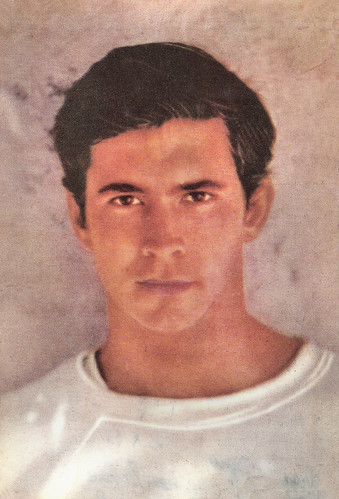
Italian promotion card by Bimospa, Roma. Photo: RCA Italiana. Promotion card for the records of Tony Perkins like First Romance and The Prettiest Girl in School.
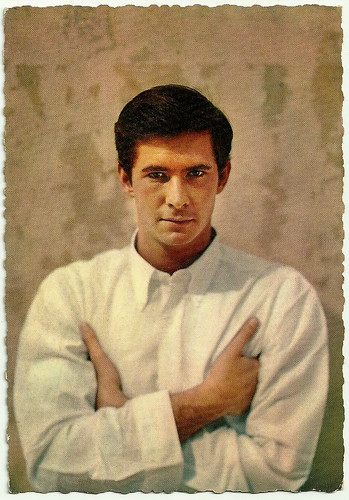
French postcard by E.D.U.G. Photo: Sam Lévin.
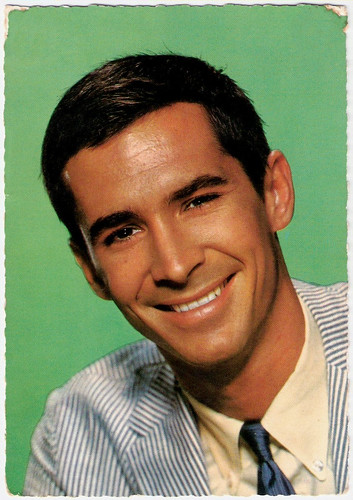
French postcard by E.D.U.G., no. 192.
Anthony Perkins was born in 1932 in New York City to Janet Esselstyn (Rane) and Osgood Perkins, an actor of both stage and film. His paternal great-grandfather was noted engraver Andrew Varick Stout Anthony. He was five when his father died.
Perkins decided to follow in his father's footsteps when, at age 15, he became a member of the Actor's Equity. He attended the Brooks School, the Browne & Nichols School, Columbia University and Rollins College. Taking the stage in summer stock, the young and shy actor embraced even the more unglamorous aspects of stage work and worked tirelessly. Subsequent performances in such Rollins College productions as The Importance of Being Ernest helped him to develop the necessary skills.
He relocated to Hollywood and made his screen debut in The Actress (George Cukor, 1953) featuring Jean Simmons. In the TV production Joey, he crooned A Little Love Goes a Long, Long Way and was signed to Epic on its strength. An album followed, Tony Perkins, arranged by vocal-music heavyweight Marty Paich and Tony had a hit with Moonlight Swim (1957). He released two more albums for RCA. John Bush at AllMusic: "Instead of the usual, light pop/rock angled at the teen market, Perkins' LPs during 1957-1958 cast him as an equally sensitive jazz singer, more Chet Baker than Ricky Nelson." However, Perkins redirected his focus to acting and never released another record.
He was nominated for a Best Supporting Actor Oscar for his second film, the Civil War drama Friendly Persuasion (William Wyler, 1956). The tall (6'2", 188 cm) Perkins also portrayed the troubled former Boston Red Sox baseball player Jimmy Piersall in the true story Fear Strikes Out (Robert Mulligan, 1957).
Perkins also acted successfully on stage. He was nominated twice for Broadway's Tony Award: in 1958, as Best Actor (Dramatic) for Look Homeward, Angel, and in 1960, as Best Actor (Musical) for Greenwillow. During this time he also co-starred in the films Desire Under the Elms (Delbert Mann, 1958) with Sophia Loren, and the romantic comedy Tall Story (Joshua Logan, 1960) opposite Jane Fonda in her first screen role.
His most memorable role to date would be Norman Bates in Psycho (Alfred Hitchcock, 1960). His portrayal of the homicidal owner of the Bates Motel made filmgoers reluctant to shower alone for decades to come. Psycho was a critical and commercial success, and gained Perkins international fame for his performance as the gender-bending sociopath. His performance gained him the Best Actor Award from the International Board of Motion Picture Reviewers. Later he played Norman Bates again in three sequels.
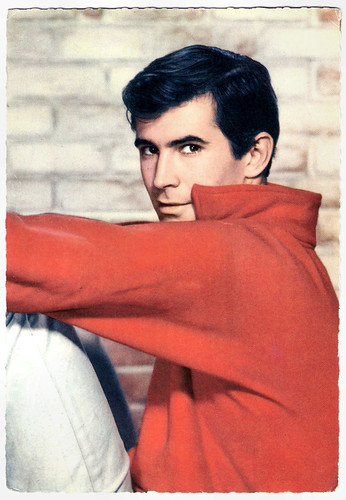
German postcard by ISV, no. B 26. Photo: MGM. Publicity still for Green Mansions (Mel Ferrer, 1959).
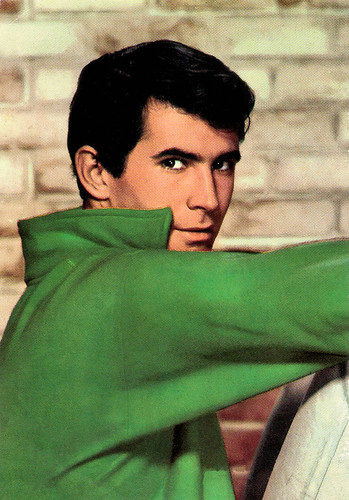
German postcard by ISV, no. B 26. Photo: MGM. Publicity still for Green Mansions (Mel Ferrer, 1959).

French postcard by Editions P.I., Paris, no. 777. Photo: Paramount.
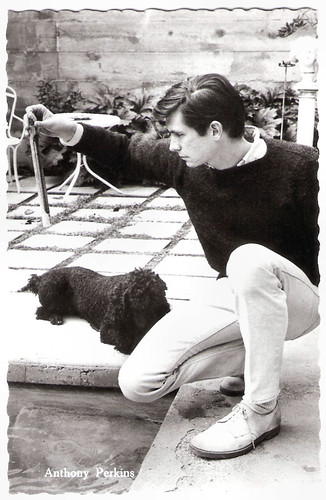
Dutch postcard by N.V. v.h. Weenenk & Snel, Baarn, no. 861.
In 1961, Anthony Perkins received considerable critical acclaim for his performance in the film Aimez-vous Brahms?/Goodbye Again (Anatole Litvak, 1961), opposite Ingrid Bergman, a performance which won him the Best Actor Award at the 1961 Cannes Film Festival. After that came a successful career in Europe, including the role of Joseph K. in the film adaptation of Franz Kafka's The Trial (Orson Welles, 1962).
His main roles include a disturbed young murderer in Pretty Poison (Noel Black, 1968), Chaplain Tappman in Catch-22 (Mike Nichols, 1970), the victim's secretary and translator in the British mystery film Murder on the Orient Express (Sidney Lumet, 1974) starring Albert Finney as Hercule Poirot, and the Dutch film Twee vrouwen/Twice of woman (George Sluizer, 1979).
Anthony Perkins was into psychoanalysis, and was treated by Dr. Mildren Newman in New York, starting in the early 1950s and continuing into the late 1970s. He was a very shy actor, especially in women's company. He had his first intimate heterosexual experience at the age of 39 while working on the film The Life and Times of Judge Roy Bean (John Milius1972) with an actress who also appeared in the film. Perkins declined to identify the actress, but Victoria Principal confirmed it was her in a People magazine article about Perkins.
In 1973, Perkins married photographer Berinthia 'Berry' Berenson. Their children are Oz Perkins (born 1974) and Elvis Perkins (born 1976). As a huge fan of Elvis Presley, Perkins named his second son after his idol. Elvis Perkins is now a musician.
Anthony Perkins became an ordained minister and performed the marriage of director Ken Russell to his second wife, Vivian Jolly, in 1983. A year later, he made headlines when he was arrested at London's Heathrow Airport for possession of eight grams of marijuana and three spots of LSD.
During 1990, he got a blood sample taken due to a palsy on the side of his face. The National Enquirer illegally had his blood sample tested for the AIDS virus, and found out that it was positive. Later that year, The National Enquirer wrote a story about his battle with AIDS, but the ironic thing was that he only found out that he was HIV positive from this article. He suspected that he probably was, but he never checked for it before the article was written.
In 1992, Anthony Perkins died in his Hollywood home of pneumonia as a complication of AIDS. On 11 September 2001, his widow and mother of his two sons, Berry Berenson was one of the 58 victims on AA-11 out of Boston that terrorists crashed into the World Trade Center.
Charles Winecoff's unauthorized biography Anthony Perkins: Split Image (1996) illuminated Perkins' early life, his bisexuality, his later drug use and life with his family. According to Winecoff, Perkins had affairs with Christopher Makos, actor Tab Hunter, dancer Rudolf Nureyev, composer/lyricist Stephen Sondheim, actor Nick Adams, and dancer-choreographer Grover Dale prior to marrying Berenson.
Trailer Psycho (1960). Source: Ageless Trailers (YouTube).
Trailer The Trial (1962). Source: Cinema : 7ème art (YouTube).
Scene from La décade prodigieuse/Ten Days' Wonder (Claude Chabriol, 1971) with Michel Piccoli, Orson Welles, Marlène Jobert and a nude Perkins. Source: Mona Fuchs (YouTube).
Scene from Twee vrouwen/Twice a Woman (1979), starring Bibi Andersson. Source: Nut01 (YouTube).
Sources: John Bush (AllMusic), Jason Buchanan (AllMovie), Tony R. Vario (IMDb), Wikipedia and IMDb.

Italian promotion card by Bimospa, Roma. Photo: RCA Italiana. Promotion card for the records of Tony Perkins like First Romance and The Prettiest Girl in School.

French postcard by E.D.U.G. Photo: Sam Lévin.

French postcard by E.D.U.G., no. 192.
Norman Bates
Anthony Perkins was born in 1932 in New York City to Janet Esselstyn (Rane) and Osgood Perkins, an actor of both stage and film. His paternal great-grandfather was noted engraver Andrew Varick Stout Anthony. He was five when his father died.
Perkins decided to follow in his father's footsteps when, at age 15, he became a member of the Actor's Equity. He attended the Brooks School, the Browne & Nichols School, Columbia University and Rollins College. Taking the stage in summer stock, the young and shy actor embraced even the more unglamorous aspects of stage work and worked tirelessly. Subsequent performances in such Rollins College productions as The Importance of Being Ernest helped him to develop the necessary skills.
He relocated to Hollywood and made his screen debut in The Actress (George Cukor, 1953) featuring Jean Simmons. In the TV production Joey, he crooned A Little Love Goes a Long, Long Way and was signed to Epic on its strength. An album followed, Tony Perkins, arranged by vocal-music heavyweight Marty Paich and Tony had a hit with Moonlight Swim (1957). He released two more albums for RCA. John Bush at AllMusic: "Instead of the usual, light pop/rock angled at the teen market, Perkins' LPs during 1957-1958 cast him as an equally sensitive jazz singer, more Chet Baker than Ricky Nelson." However, Perkins redirected his focus to acting and never released another record.
He was nominated for a Best Supporting Actor Oscar for his second film, the Civil War drama Friendly Persuasion (William Wyler, 1956). The tall (6'2", 188 cm) Perkins also portrayed the troubled former Boston Red Sox baseball player Jimmy Piersall in the true story Fear Strikes Out (Robert Mulligan, 1957).
Perkins also acted successfully on stage. He was nominated twice for Broadway's Tony Award: in 1958, as Best Actor (Dramatic) for Look Homeward, Angel, and in 1960, as Best Actor (Musical) for Greenwillow. During this time he also co-starred in the films Desire Under the Elms (Delbert Mann, 1958) with Sophia Loren, and the romantic comedy Tall Story (Joshua Logan, 1960) opposite Jane Fonda in her first screen role.
His most memorable role to date would be Norman Bates in Psycho (Alfred Hitchcock, 1960). His portrayal of the homicidal owner of the Bates Motel made filmgoers reluctant to shower alone for decades to come. Psycho was a critical and commercial success, and gained Perkins international fame for his performance as the gender-bending sociopath. His performance gained him the Best Actor Award from the International Board of Motion Picture Reviewers. Later he played Norman Bates again in three sequels.

German postcard by ISV, no. B 26. Photo: MGM. Publicity still for Green Mansions (Mel Ferrer, 1959).

German postcard by ISV, no. B 26. Photo: MGM. Publicity still for Green Mansions (Mel Ferrer, 1959).

French postcard by Editions P.I., Paris, no. 777. Photo: Paramount.

Dutch postcard by N.V. v.h. Weenenk & Snel, Baarn, no. 861.
Split Image
In 1961, Anthony Perkins received considerable critical acclaim for his performance in the film Aimez-vous Brahms?/Goodbye Again (Anatole Litvak, 1961), opposite Ingrid Bergman, a performance which won him the Best Actor Award at the 1961 Cannes Film Festival. After that came a successful career in Europe, including the role of Joseph K. in the film adaptation of Franz Kafka's The Trial (Orson Welles, 1962).
His main roles include a disturbed young murderer in Pretty Poison (Noel Black, 1968), Chaplain Tappman in Catch-22 (Mike Nichols, 1970), the victim's secretary and translator in the British mystery film Murder on the Orient Express (Sidney Lumet, 1974) starring Albert Finney as Hercule Poirot, and the Dutch film Twee vrouwen/Twice of woman (George Sluizer, 1979).
Anthony Perkins was into psychoanalysis, and was treated by Dr. Mildren Newman in New York, starting in the early 1950s and continuing into the late 1970s. He was a very shy actor, especially in women's company. He had his first intimate heterosexual experience at the age of 39 while working on the film The Life and Times of Judge Roy Bean (John Milius1972) with an actress who also appeared in the film. Perkins declined to identify the actress, but Victoria Principal confirmed it was her in a People magazine article about Perkins.
In 1973, Perkins married photographer Berinthia 'Berry' Berenson. Their children are Oz Perkins (born 1974) and Elvis Perkins (born 1976). As a huge fan of Elvis Presley, Perkins named his second son after his idol. Elvis Perkins is now a musician.
Anthony Perkins became an ordained minister and performed the marriage of director Ken Russell to his second wife, Vivian Jolly, in 1983. A year later, he made headlines when he was arrested at London's Heathrow Airport for possession of eight grams of marijuana and three spots of LSD.
During 1990, he got a blood sample taken due to a palsy on the side of his face. The National Enquirer illegally had his blood sample tested for the AIDS virus, and found out that it was positive. Later that year, The National Enquirer wrote a story about his battle with AIDS, but the ironic thing was that he only found out that he was HIV positive from this article. He suspected that he probably was, but he never checked for it before the article was written.
In 1992, Anthony Perkins died in his Hollywood home of pneumonia as a complication of AIDS. On 11 September 2001, his widow and mother of his two sons, Berry Berenson was one of the 58 victims on AA-11 out of Boston that terrorists crashed into the World Trade Center.
Charles Winecoff's unauthorized biography Anthony Perkins: Split Image (1996) illuminated Perkins' early life, his bisexuality, his later drug use and life with his family. According to Winecoff, Perkins had affairs with Christopher Makos, actor Tab Hunter, dancer Rudolf Nureyev, composer/lyricist Stephen Sondheim, actor Nick Adams, and dancer-choreographer Grover Dale prior to marrying Berenson.
Trailer Psycho (1960). Source: Ageless Trailers (YouTube).
Trailer The Trial (1962). Source: Cinema : 7ème art (YouTube).
Scene from La décade prodigieuse/Ten Days' Wonder (Claude Chabriol, 1971) with Michel Piccoli, Orson Welles, Marlène Jobert and a nude Perkins. Source: Mona Fuchs (YouTube).
Scene from Twee vrouwen/Twice a Woman (1979), starring Bibi Andersson. Source: Nut01 (YouTube).
Sources: John Bush (AllMusic), Jason Buchanan (AllMovie), Tony R. Vario (IMDb), Wikipedia and IMDb.
No comments:
Post a Comment